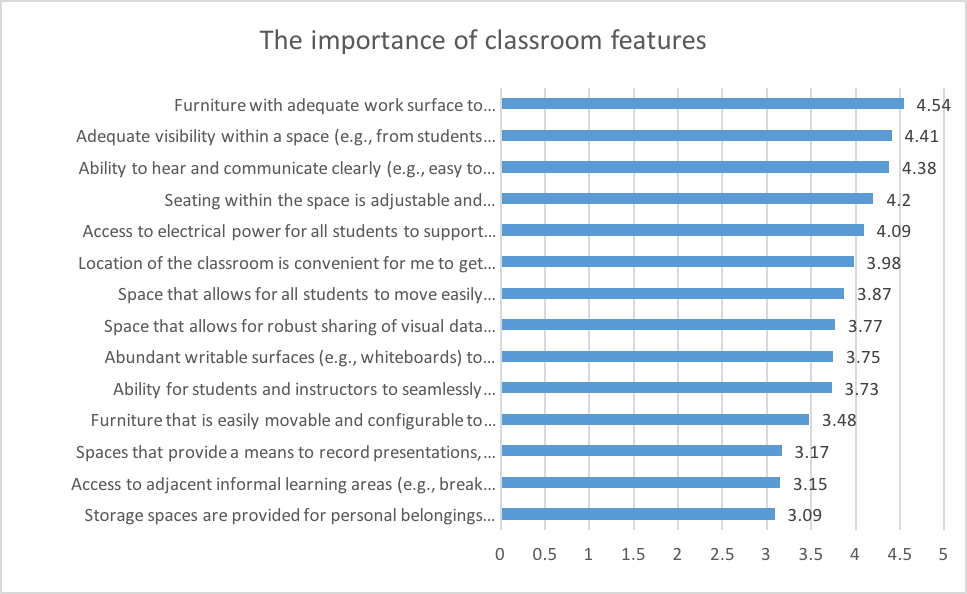IUPUI Student Survey
Importance of Classroom Attributes
Students assessed the importance of classroom features on a Likert-scale ranging from 1 (not important at all) to 5 (extremely important). Students rated that having access to adequate work surfaces for multiple devices/materials (M=4.54) was most important, followed by adequate visibility within a space (M=4.41), the ability to hear and communicate clearly (M=4.38), adjustable/comfortable seating (M=4.20), and electrical power access (M=4.09) (see Figure 2). Findings from the student survey indicate that students require adequate work space to carry out note taking and learning activities, while supported by comfortable seating and access to power outlets. Students assigned less weight to classroom features that provide storage spaces for personal belongings and access to adjacent informal learning areas (see Table 2).

Figure 2. The mean score of the importance of classroom features
| Question | Not important at all | Slightly important | Moderately important | Very important | Extremely important |
| Furniture with adequate work surface to accommodate multiple devices and materials that you may bring to class. | 0.0% | 1.0% | 6.2% | 30.9% | 61.9% |
| Adequate visibility within a space (e.g., from students to instructors, to course content, to demonstrations, to other students) | 0.0% | 1.2% | 5.4% | 44.2% | 49.2% |
| Ability to hear and communicate clearly (e.g., easy to hear from back of room, push to talk microphones available in large spaces) | 0.4% | 3.1% | 10.3% | 30.3% | 56.0% |
| Seating within the space is adjustable and comfortable for extended lengths of time | 0.4% | 5.0% | 14.6% | 34.0% | 46.0% |
| Access to electrical power for all students to support the wide variety of technologies used in learning activities | 1.7% | 6.6% | 18.1% | 28.8% | 44.9% |
| Location of the classroom is convenient for me to get to as a student | 1.0% | 8.5% | 20.8% | 31.1% | 38.6% |
| Space that allows for all students to move easily around the classroom (e.g., to support communication, to facilitate interaction) | 1.0% | 7.0% | 29.0% | 29.4% | 33.5% |
| Space that allows for robust sharing of visual data making it easily available, visible, and readable for all students | 1.7% | 9.7% | 26.3% | 34.8% | 27.6% |
| Abundant writable surfaces (e.g., whiteboards) to facilitate communication when working with other students and groups | 2.3% | 11.3% | 26.2% | 29.3% | 30.9% |
| Ability for students and instructors to seamlessly manage audio/visual content across multiple output systems (e.g., installed displays, computers, mobile devices) | 1.7% | 10.9% | 28.0% | 32.1% | 27.4% |
| Furniture that is easily movable and configurable to support a range of learning activities | 5.6% | 13.8% | 31.9% | 24.9% | 23.9% |
| Spaces that provide a means to record presentations, group interactions, or conversations with local and remote students, and make those artifacts accessible asynchronously | 8.7% | 22.3% | 31.1% | 19.6% | 18.4% |
| Access to adjacent informal learning areas (e.g., break out spaces for short collaborative meetings, after-hours study spaces) | 8.0% | 20.6% | 35.2% | 21.0% | 15.2% |
| Storage spaces are provided for personal belongings (e.g., under seat, designated location within the room) | 9.3% | 25.9% | 29.0% | 18.5% | 17.3% |
Table 2. Importance of classroom attributes

